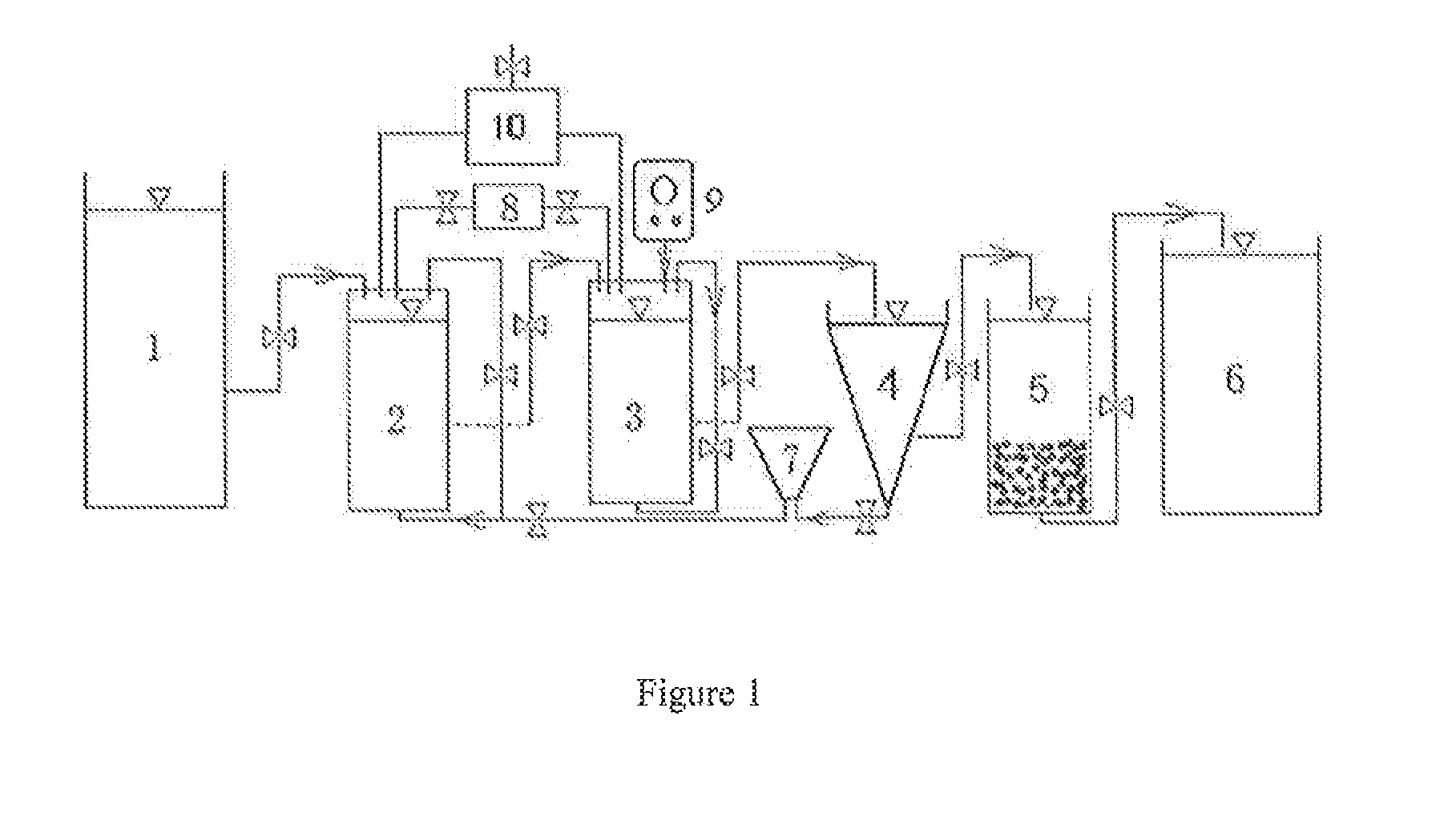Modified activated sludge-based two-compartment treatment method for processing nitrate-contaminated drinking water and the device thereof
a technology of activated sludge and treatment method, which is applied in the direction of biological water/sewage treatment, water/sewage treatment by oxidation, multi-stage water/sewage treatment, etc., and can solve the problems of increasing nitrate contamination of drinking water, harmful effects on human health, and low bacterial yield of autotrophic denitrification
- Summary
- Abstract
- Description
- Claims
- Application Information
AI Technical Summary
Benefits of technology
Problems solved by technology
Method used
Image
Examples
embodiments
Example 1
[0020]The device comprises a raw water tank 1, a first TiO2-modified heterotrophic denitrifying activated sludge bioreactor 2, a second TiO2-modified heterotrophic and hydrogenotrophic denitrifying activated sludge bioreactor 3, a settling tank 4, an ozone disinfection and activated carbon filtration tank 5, a storage tank 6, a precipitates treatment tank 7, a concentrated carbon source tank 8, an electrolytic hydrogen production device 9, and a pressure regulating bag 10.
[0021]The concentrated carbon source tank 8 is connected to the first bioreactor 2 and second bioreactor 3 by a peristaltic pump. The pressure regulating bag 10 is connected to the headspace of the first bioreactor 2 and the second bioreactor 3 to regulate their headspace pressures during water filling and drawing operation (The solenoid valve of the pressure regulating bag is open when the bag pressure is above 0.110 MPa and is closed when the bag pressure is below 0.105 MPa). The raw water tank 1, the fi...
example 2
[0030]Raw water nitrate level was 42 mgN / L; the first bioreactor operated for 110 min and settled for 30 min before drainage; the second bioreactor operated for 110 min and settled for 30 min before drainage; the settling tank 4 settled for 90 min before drainage; the whole duration of each cycle of operation was controlled to be 2.5 h; the other operation conditions were same as described in Example 1. The results after treatment are shown in Table 2.
TABLE 2Changes in water quality of nitrate-contaminateddrinking water before and after 2.5 h-treatmentwith the two-compartment nitrate removal systemAlkalinitySOCNO3—NNO2—NpH(mM)(mg / L)(mg / L)(mg / L)Before7.73.92.2420After8.26.58
example 3
[0031]Raw water nitrate level was 35 mgN / L. The first bioreactor was added with 20 mL of concentrated mixed organic carbon sources solution (125.0 mM acetic acid, 41.7 mM ethanol). The amount of mixed organic carbon sources added accounted liar 61.5% of that required for completely removing nitrate from raw water through heterotrophic denitrification. Water in the first bioreactor 2 was treated for 80 min for nitrate removal with intermittent anaerobic aeration (20 s anaerobic aeration, 4 min idling), settled for 30 min, and then drained (3 L) into the second bioreactor 3. The second bioreactor 3 was added with 7 mL of concentrated mixed organic carbon sources solution (125.0 mM acetic acid, 41.7 mM ethanol). The amount of mixed organic carbon sources added accounted for 21.5% of that required for completely removing nitrate from raw water through heterotrophic denitrification. The second bioreactor 3 was also added with 120 mL of hydrogen gas intermittently provided by the electrol...
PUM
 Login to View More
Login to View More Abstract
Description
Claims
Application Information
 Login to View More
Login to View More - R&D
- Intellectual Property
- Life Sciences
- Materials
- Tech Scout
- Unparalleled Data Quality
- Higher Quality Content
- 60% Fewer Hallucinations
Browse by: Latest US Patents, China's latest patents, Technical Efficacy Thesaurus, Application Domain, Technology Topic, Popular Technical Reports.
© 2025 PatSnap. All rights reserved.Legal|Privacy policy|Modern Slavery Act Transparency Statement|Sitemap|About US| Contact US: help@patsnap.com

